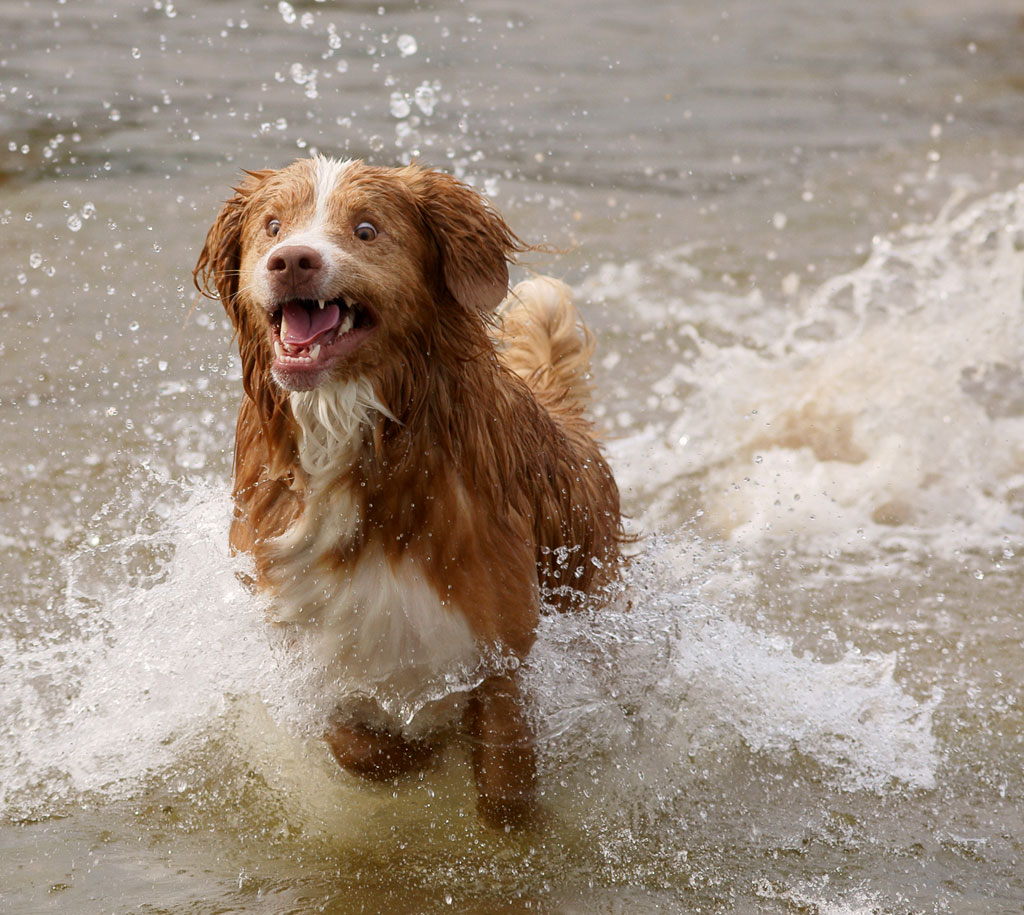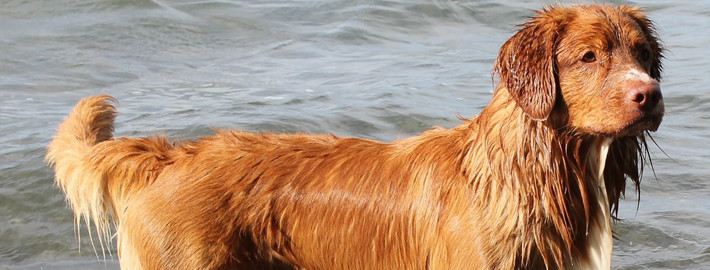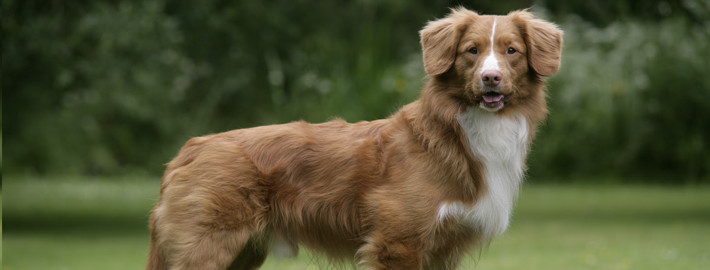What makes the Nova Scotia Duck Tolling Retriever Unique?
This Canadian breed originated in Yarmouth County, Nova Scotia and is well-known for its unique method of hunting waterfowl. It has since been named the official dog breed of its’ home province.
Page Contents

Is the Nova Scotia Duck Tolling Retriever Right For You?
Nova Scotia Duck Tolling Retrievers are generally intelligent, affectionate, and playful. They make wonderful companions for children. These dogs are also friendly towards other pets. Although members of this breed can be somewhat reserved around strangers, they make friends quickly and shyness is considered to be a flaw in adult animals.
Owners should be aware that these dogs can become quite destructive if they receive insufficient amounts of exercise or attention. Some members of this breed make a high pitched howling sound known as the ‘Toller scream’ when they are excited. As a result, Nova Scotia Duck Tolling Retrievers are not good candidates for apartment life.
In 5 Words
- Outgoing
- Patient
- Loving
- Alert
- Intelligent
Characteristics
Learn About the Nova Scotia Duck Tolling Retriever
Description
General Description
Members of this breed greatly resemble small, red-coated Golden Retrievers. Due to their preferred hunting style, Nova Scotia Duck Tolling Retrievers have sprightlier gaits and smaller statures than many similar breeds. These dogs have powerful, athletic bodies that enable them to hunt without any sign of fatigue. They additionally possess strong jaws, wide chests, strong necks, rounded skulls, and wedge shaped heads that are in proportion to their bodies. High set, triangular ears are another breed feature.
According to AKC breed standards, Nova Scotia Duck Tolling Retrievers should have a sad or troubled expression in their eyes unless they are engaged in an activity. When the dogs are working, their long, feathered tails should also be continually in motion. Members of this breed also have webbed feet that help them swim. Owners have the choice of removing their pet’s front dewclaws or not, but AKC regulations clearly state that the dewclaws on a dog’s hind legs must be removed or the individual in question will be disqualified from the show ring.
Size
Females of this breed stand approximately 18 to 19 inches (45 to 48 centimeters) in height. They typically weigh between 37 and 44 pounds (17 and 20 kilograms). Male dogs are somewhat larger. These individuals stand between 19 and 20 inches (48 and 51 centimeters) tall and weigh anywhere from 44 to 51 pounds (20 to 23 kilograms).
Coat
Nova Scotia Duck Tolling Retrievers have a double-coat that repels water. Their fur is generally straight in texture and of medium length. Excessively thick coats are considered a serious flaw in the show ring. According to the AKC breed standards, red is the only acceptable color for these dogs yet Nova Scotia Duck Tolling Retrievers will often have white markings on their faces, chests, tails, and/or feet. It is thought that this coloration may serve to help members of this breed get the attention of nearby waterfowl.. However, dogs without white patches are not penalized in the show ring and individuals with incorrect markings may be completely disqualified from competitions.
Short History of the Nova Scotia
The Nova Scotia Duck Tolling Retriever was developed during the early 1800s. It is possible that this breed may have Cocker Spaniel, Golden Retriever, Irish Setter, St. John’s Water Dog, and/or Kooikerhondje ancestry in its’ bloodlines. However, it is certain that these dogs helped their human owners hunt waterfowl using a technique known as ‘tolling’. Thus, the dogs served to attract the attention of nearby birds and draw them to where their human hunting partner was waiting. The game in question would then be shot for the dog or dogs to retrieve.
Nova Scotia Duck Tolling Retrievers have not been quick to catch on in the years since they were first introduced. Although the Canadian Kennel Club recognized this breed in 1945, the American Kennel Club (AKC) did not follow suit until 2001. However, two years later the Nova Scotia Duck Tolling Retriever was made a part of the AKC’s sporting group and the breed has begun to slowly grow in popularity.
Temperament
The most important thing to know about this breed is that Nova Scotia Duck Tolling Retrievers are anything but couch potatoes. In fact, these dogs are only suitable for active families or folks that go hunting on a regular basis. Members of this breed are at their best when they are given some sort of job to perform. These active dogs are very amenable to playing fetch and hunting waterfowl but they are also good candidates for agility and obedience competitions. They also make excellent search and rescue animals.
Nova Scotia Duck Tolling Retrievers are generally intelligent, affectionate, and playful. They make wonderful companions for children. These dogs are also friendly towards other pets. Although members of this breed can be somewhat reserved around strangers, they make friends quickly and shyness is considered to be a flaw in adult animals.
Owners should be aware that these dogs can become quite destructive if they receive insufficient amounts of exercise or attention. Some members of this breed make a high pitched howling sound known as the ‘Toller scream’ when they are excited. As a result, Nova Scotia Duck Tolling Retrievers are not good candidates for apartment life.
Caring for Your Nova Scotia Duck Tolling Retriever
General Health
At the moment, Nova Scotia Duck Tolling Retrievers have an average lifespan of 10 to 14 years. This could change as a growing demand for the dogs and a limited breeding stock could easily increase the percentage of individuals that suffer from health conditions. Members of this breed are currently susceptible to meningitis, dysplasia, Addison’s disease, progressive retinal atrophy, and various types of thyroid problems.
Care
Daily
Members of this incredibly energetic breed need at least two briskly paced walks per day. They also enjoy jogging.
Weekly
Once per week, members of this breed will need to have their coats groomed using a brush with firm bristles. It is also important for owners to regularly clean their dog’s teeth clean using a canine toothbrush and vet-approved toothpaste that so that the animal in question maintains good oral health.
Monthly
Parasite prevention medications are a must for all dog breeds. These products should generally be administered at least once a month in order from them to be effective.
Grooming & Bathing
Nova Scotia Duck Tolling Retrievers only shed modest amounts of fur so a weekly brushing should keep their coats free of tangles and mats. These dogs also go through a period of heavy shedding twice a year when more frequent brushing may be needed. A regular dusting with dry shampoo is also recommend but these dogs will only have to be fully bathed when they get dirty.
Exercise & Training
On the whole, Nova Scotia Duck Tolling Retrievers are quick learners and, being people-pleasers, they respond well to rewards based training. Owners should nonetheless note that these dogs are likely to lose interest in their training sessions if their lessons grow too repetitive. Nova Scotia Duck Tolling Retrievers also have a stubborn streak, which can appear from time to time. Furthermore, individuals that are not well-socialized may display aggressive tendencies. However, properly trained dogs will follow their leader’s cues on how to respond to any given situation.











